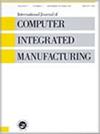Working with collaborative robots and its influence on levels of working stress
IF 4
3区 工程技术
Q2 COMPUTER SCIENCE, INTERDISCIPLINARY APPLICATIONS
International Journal of Computer Integrated Manufacturing
Pub Date : 2023-09-30
DOI:10.1080/0951192x.2023.2263428
引用次数: 0
Abstract
The use and the rapid growth of the cobot in industry are changing working conditions. New jobs can imply new advantages and inconveniences, which call for new occupational risk assessments. The aim here is to assess occupational risks in terms of mental stress, so as to determine whether a worker experiences greater stress when working in collaboration with a cobot rather than with another person while performing the same production-line process. The study involved a total of 32 volunteers of various ages, with no previous experience of cobots. An eye-tracker system that records a range of biometric data was used to quantify stress. Pupil diameter was mainly used in this investigation, as well as the number of gaze fixations by zones. The data registered were analyzed using the T-test method, with which data on two groups can be compared to test for significant differences. In addition, other secondary parameters were also analyzed, such as the time required to complete each test, and the number of errors that were committed. Among the most important conclusions, it was noted that working with cobots in no way increased stress levels, confirming one of the objectives for which these robots were designed.与协作机器人合作及其对工作压力水平的影响
协作机器人在工业中的使用和快速增长正在改变工作条件。新的工作可能意味着新的优势和不便,这需要新的职业风险评估。这里的目的是评估精神压力方面的职业风险,从而确定工人在与协作机器人合作时是否比在执行同一生产线过程时与另一个人合作时承受更大的压力。这项研究共涉及32名不同年龄的志愿者,他们之前没有使用协作机器人的经验。一种记录一系列生物特征数据的眼动追踪系统被用来量化压力。本研究主要使用瞳孔直径,以及区域注视次数。登记的数据采用t检验方法进行分析,两组数据可以进行比较,检验是否有显著差异。此外,还分析了其他次要参数,例如完成每个测试所需的时间,以及所提交的错误数量。在最重要的结论中,有人指出,与协作机器人一起工作绝不会增加压力水平,这证实了设计这些机器人的目标之一。
本文章由计算机程序翻译,如有差异,请以英文原文为准。
求助全文
约1分钟内获得全文
求助全文
来源期刊
CiteScore
9.00
自引率
9.80%
发文量
73
审稿时长
10 months
期刊介绍:
International Journal of Computer Integrated Manufacturing (IJCIM) reports new research in theory and applications of computer integrated manufacturing. The scope spans mechanical and manufacturing engineering, software and computer engineering as well as automation and control engineering with a particular focus on today’s data driven manufacturing. Terms such as industry 4.0, intelligent manufacturing, digital manufacturing and cyber-physical manufacturing systems are now used to identify the area of knowledge that IJCIM has supported and shaped in its history of more than 30 years.
IJCIM continues to grow and has become a key forum for academics and industrial researchers to exchange information and ideas. In response to this interest, IJCIM is now published monthly, enabling the editors to target topical special issues; topics as diverse as digital twins, transdisciplinary engineering, cloud manufacturing, deep learning for manufacturing, service-oriented architectures, dematerialized manufacturing systems, wireless manufacturing and digital enterprise technologies to name a few.

 求助内容:
求助内容: 应助结果提醒方式:
应助结果提醒方式:


